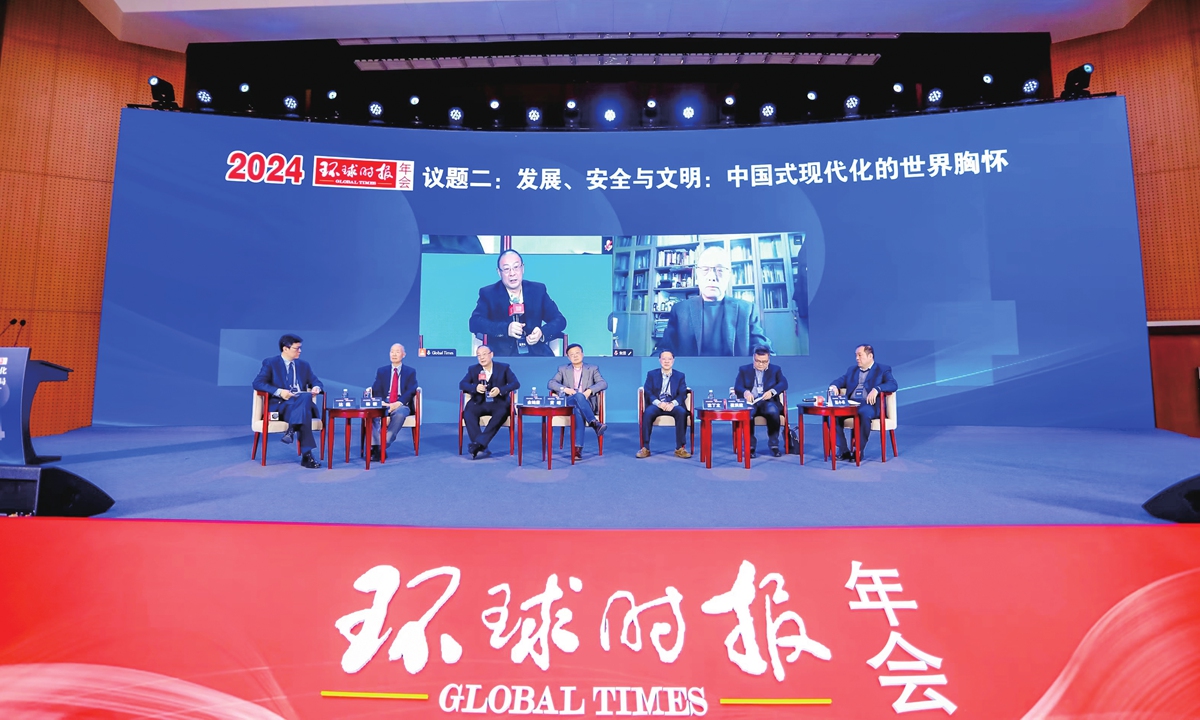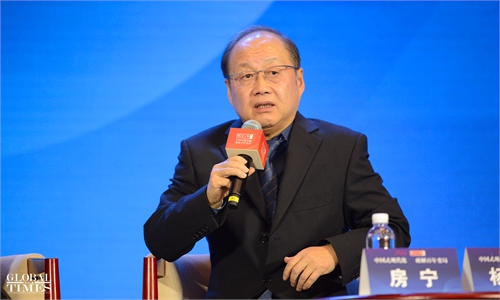
The 2024 Global Times Annual Conference is held in Beijing on Saturday. Photo: GT
The 2024 Global Times Annual Conference, themed "Following the Path of Chinese Modernization, Coping with Changes Unseen in a Century" was held in Beijing on Saturday. To understand the implications of Chinese modernization in this turbulent world and analyze what China can do to stay on this path and overcome various challenges in 2024, the Conference invited over 100 representatives from all walks of life as well as experts and scholars to share their views on four major themes. The following contains excerpts from the first theme - "Population, industry and market: the underlying logic of Chinese modernization."
Comprehending Chinese modernization from a population perspective
Yang Xuedong,
a professor of political science at Tsinghua University:
To understand the underlying logic of Chinese modernization, it is necessary to start with the population. Population is the most basic element in comprehending a political phenomenon. When discussing modernization, we are referring to the modernization of a collective group. Without understanding the population, it is impossible to develop a path toward modernization. Furthermore, people are an active element. When discussing modernization, we are also considering how to actively engage this particular group in the process of modernization. The path to successful modernization lies in enabling the people to become the masters of the country, forming a political consensus, and generating collective action. All successful paths of modernization are able to organically integrate the population, individuals, and public sentiment.
Lu Jiehua,
a professor of sociology at Peking University:
Modernization with a large population has three main characteristics. First, it represents a new form of civilization that will reshape the discourse system dominated by Western modernization. The modernization with a large population in China will undoubtedly create a new form of civilization with Chinese characteristics, based on the national population situation.
Second, it is not simply borrowing the practices of Western modernization, but placing greater emphasis on individuals. To achieve modernization in a society with over 1.4 billion people, it is necessary to rely on highly qualified individuals. Ways of thinking, values, and behaviors of individuals are constantly evolving in the process of modernization. And individual modernization is the premise and destination of overall modernization.
Third, modernization bolstered by a large population will become a huge advantage and driving force for the path of Chinese modernization. The enormous population represents a vast market space and immense consumption potential. In the past, the quantity of the labor force was mostly seen as a demographic dividend. With the improvement in population quality, the large population will play an important role in the transformation and upgrading of the consumption structure during the modernization process, accelerating the construction of a new development pattern with domestic circulation as the mainstay and domestic-international dual circulation mutually reinforcing.
Yuan Xin,
a professor from the Institute of Population and Development at Nankai University:
The first meeting of the commission under the 20th CPC Central Committee held in May pointed out that China's population development has shown the characteristics of low fertility, population aging, and regional variations in population growth and decline. We must have a comprehensive understanding and correct view of the new situation in China's population development.
The population of people aged 60 and above in China is now more than 280 million, accounting for 19.8 percent of the total population, indicating that we have entered a moderately aged society. The age structure of the entire population is also changing. We will gradually transition to a society focused on elderly care.
It should also be pointed out that the improvement of China's population quality is significant. In 2022, the gross enrollment rate for high school education increased to over 90 percent, and the gross enrollment ratio in higher education reached 59.6 percent. China has steadily entered the stage of popularizing higher education. The number of university graduates in China is the highest in the world. The comprehensive quality of the population has greatly improved, and human capital has become a new source of power for China's modernization.
These four aspects bring both opportunities and challenges. How to fully seize the opportunities and calmly respond to the challenges is an important issue that deserves attention in the process of Chinese modernization.
Integrating the development of silver economy with modernization
Lu: How should the deadlock of population be broken?
First of all, we need to change the mind-set that China is a young society and think from the perspective of an aging society. Second, we should fully stimulate the vitality and driving force of the population. We should not only put emphasis on childbirth, parenting and education, but also consider aspects such as pension, medical care and employment. Third, to promote economic and social development, we need to shift from quantitative demographic dividends to tapping qualitative demographic dividends, such as unleashing education dividends, gender dividends, etc.
Finally, China is in the process of rapid urbanization. The Seventh National Population Census indicates that China's migrant population has reached 376 million, accounting for nearly a quarter of the total population. This is a huge driving force for China's social and economic development. Increasing efforts to promote citizenization and provide basic public services to more migrant populations will have a positive effect on population development.
Yuan: The size of China's population will continue to remain huge. By the middle of this century, it will still be one of the two super-population countries in the world with a population of more than 1 billion.
China's demographic dividends have not disappeared, but are transforming from a human resource-based advantage to a human capital-based advantage. China has actually relied on its human resource-based demographic dividends, labor-intensive industrial structure and high labor participation rate to create an average annual GDP growth rate of more than 9 percent for about 40 years. Although the numerical advantage of population is now weakening, it still exists to a certain extent. More importantly, the quality of China's population is improving. Tens of millions of college graduates and about 4 million graduates of technical colleges every year will become the new driving force for China's future economic development.
Whether such demographic opportunities can be transformed into demographic dividends depends on economic decision-making and the economic development environment. One of the most important factors is employment. As China's demographic opportunities are transforming, the means of harvesting demographic dividends should also transform accordingly, for example, the silver economy. We have entered a moderately aging society, which is an opportunity to develop a silver economy and aging industries. The silver economy is more than just nursing homes. It is a variety of economic activities and industrial structures that meet the consumption of the elderly. The financial industry should be the foundation of the entire silver economy.
Lu: An aging population is not a bad thing. An aging population means that people's life span has increased. China's society and economy are developing steadily, people's quality of life continues to improve, and the income level and consumption power of the elderly have also increased. Therefore, in the age of longevity, there is huge consumption demand in the silver economy. The silver economy is not traditional social services such as nursing, but more modern services, such as insurance. To develop the silver economy, combining the silver economy with the digital economy is very important.
Establishing city clusters with radiating power in central and western regions
Fang Ning,
chair professor at Sichuan University:
Whether it is economic development or modernization, China's development now requires new space. China's reform and opening-up have achieved great success. The country has undergone earth-shaking changes. However, there is one problem that has not changed, the issue raised by Chinese geographer Hu Huanyong in 1935 regarding the Heihe-Tengchong Line, also called the Aihui-Tengchong Line. In other words, in the southeastern coastal areas of China, such as the Pearl River Delta, Yangtze River Delta, Bohai Rim region, as well as major cities like Beijing, Shanghai, Guangzhou and Shenzhen, development has been relatively sufficient. However, the development of the vast central and western regions and the northeastern region has lagged behind the southeastern coastal areas and major cities. Overall, this barrier needs to be broken, and we need new development space.
Yang: In terms of development, I think the highlight should be urbanization. Urbanization is the most important aspect and a crucial part of China's future development. No country has achieved balanced development. They have all made breakthroughs in certain areas. For China to achieve further high-quality development, it is important to promote the formation of city clusters. In addition to the existing coastal city clusters, it is also crucial to form some influential city clusters in the central and western regions.
He Weiwen,
an executive council member of the China Society for World Trade Organization Studies:
Chinese modernization has five major characteristics: a huge population, common prosperity for all people, coordination between material civilization and spiritual civilization, harmonious coexistence between humans and nature, and the pursuit of peaceful development. Due to the large population, Chinese modernization will be different from developed countries. That's to say, the traditional path of achieving social modernization through industrialization may not necessarily work in China. China has a population of over 1.4 billion, which is more than the total population of all developed countries combined. Historically, developed countries, especially those with a population of over 100 million, achieved modernization mainly through industrialization.
For Chinese modernization, it is not enough to rely solely on industries; we also need to master cutting-edge technologies such as artificial intelligence, big data, and quantum computing, and apply them extensively in the primary, secondary and tertiary industries to better promote modernization.
Second, China's modernization cannot escape the laws and commonalities of modern development. By utilizing the latest cutting-edge technologies and significantly improving productivity, we can lead in social, economic, production and living standards, and China's modernization will still follow this path. Third, we need to actively develop new productive forces with the market as the main driver and enterprises as the main body. Fourth, we also need to rely on "two markets," namely the domestic and international markets. We need to strengthen independent research and development for the domestic market and achieve a domestic circulation. For the international market, we should absorb all excellent resources from the world and inject them into new productive forces. In the next five to 10 years, or even longer, as an active participant and promoter of globalization, China must adhere unwaveringly to a high level of opening-up and use opening-up to break barriers.


